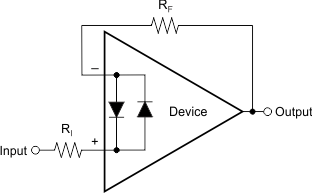SBOS859B March 2018 – July 2018 INA1620
PRODUCTION DATA.
- 1 Features
- 2 Applications
- 3 Description
- 4 Revision History
- 5 Pin Configuration and Functions
- 6 Specifications
- 7 Detailed Description
- 8 Application and Implementation
- 9 Power Supply Recommendations
- 10Layout
- 11Device and Documentation Support
- 12Mechanical, Packaging, and Orderable Information
7.3.6 Input Protection
The amplifier input pins of the INA1620 are protected from excessive differential voltage with back-to-back diodes, as Figure 47 shows. In most circuit applications, the input protection circuitry has no consequence. However, in low-gain or G = +1 circuits, fast-ramping input signals can forward bias these diodes because the output of the amplifier cannot respond quickly enough to the input ramp. If the input signal is fast enough to create this forward-bias condition, the input signal current must be limited to 10 mA or less. If the input signal current is not inherently limited, use an input series resistor (RI) or a feedback resistor (RF) to limit the signal input current. This input series resistor degrades the low-noise performance of the INA1620 and is examined in the Noise Performance section. Figure 47 shows an example configuration when both current-limiting input and feedback resistors are used.
 Figure 47. Pulsed Operation
Figure 47. Pulsed Operation